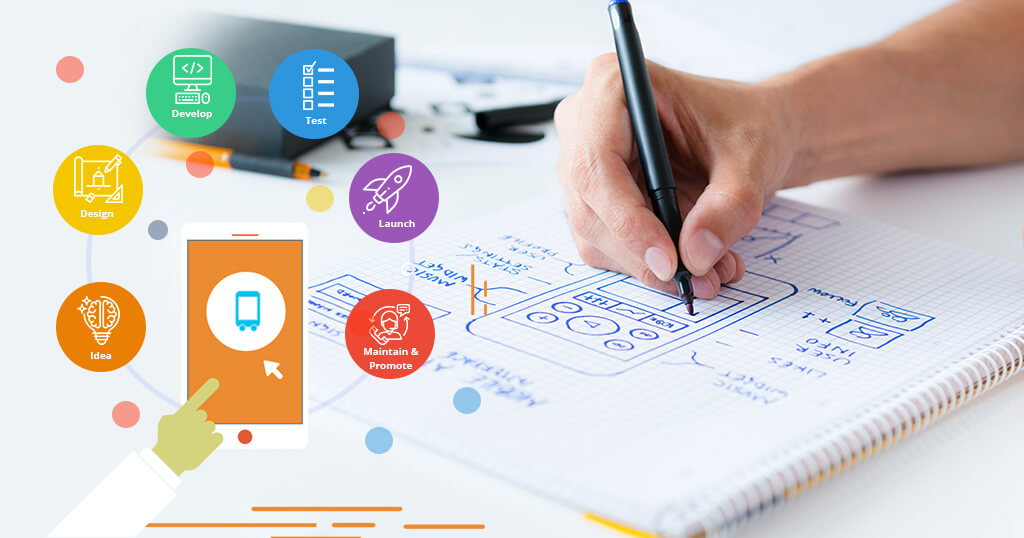Mobile app development process at Coming is standardized and, in fact, not much different from the processes applied to develop other software. In this article, let’s go through the steps with our team to bring a mobile app to users, from ideation to launch and beyond.
Mobile App Development Process at Coming
To develop a mobile app, Coming follows a 7-step process:
Step 1: Ideation
The starting point of each project is different. Many clients come to Coming with only an idea. However, some clients have prepared quite detailed documentation. These documents often contain the requirements or features they expect in the upcoming app.

Regardless of the client’s requirements, Coming’s task is to clarify the app concept from the outset. Who will use this app? On which platform will the app be built? Are there any similar products on the market? What business goals do clients expect to achieve by developing the mobile app? What is the marketing strategy for the app? These are just a few of the many questions the team needs to clarify with the client from the beginning.
To ensure the best project outcome, Coming always tries to interact with as many stakeholders as possible, such as the Product Owner, Designers, Marketing team, etc., on the client’s side. This helps the team understand the project’s requirements thoroughly and devise the most effective solutions.
Step 2: Research
Once the idea is solidified, the next step in mobile app development is research. This is a crucial step in the process. The more thorough the research, the better the product strategy. This can also reduce the cost of mobile app development and save a lot of development time.
What needs to be researched when developing a mobile app?
Research will focus on various aspects including:
- Target Customers: Understanding what future customers expect from the app. What are their challenges, goals, behaviors, technology capabilities, and preferred devices? This information helps the team optimize the user experience in later stages.
- Competitors: Coming always researches and analyzes existing products on the market to see their solutions and the technology they use. This helps identify their strengths and what we can do better.
- Industry Standards: Each industry has different standards, regulations, and technologies. The team needs to thoroughly research the industry, analyze, and make appropriate choices to help develop the mobile app.
- Business and Technology Model: Understanding the client’s business model, technology, and operation methods is essential. This helps Coming choose the right technology and design the appropriate mobile experience, ensuring consistency with brand identity and the services your business offers.
Step 3: UX Design
User Experience (UX) design is the part the team enjoys most in the mobile app development process because it reveals how the app will look and function.
Step 4: UI Design
The UI design step in the mobile app development process is incredibly interesting. Here, you get to see exactly how your app will look when users interact with it.

At the end of the UI design step, you will have a colorful, interactive prototype that simulates the real app. Prototypes are usually created on Figma or similar design applications.
Step 5: Mobile App Development and Software Testing
- Mobile App Development: After the client approves the UI design, the software development team starts their work. To minimize errors and avoid extending the development process, the development team and the design team need to maintain clear communication, ensuring timely clarifications on design details.
- Software Testing: Quality assurance is crucial in every app development process. At Coming, the team emphasizes thorough testing before delivering the product to users. Testing the app’s features and performance ensures it runs smoothly and loads quickly. User experience tests and compatibility tests across various devices are also essential to ensure the app works well with different screen ratios.
Step 6: App Deployment
When the client is satisfied with the app, the final step in the mobile app development process is app deployment, meaning releasing the app on app stores like the App Store or Google Play.
Once the app is available on the market, you will receive statistics on downloads and user feedback. Although this seems like the end of the app development process, it isn’t entirely.
Step 7: App Monitoring and Optimization
After the app is launched, Coming continues to monitor its performance and customer feedback. The team proactively interacts with customers to clarify and resolve issues.
Based on client goals, Coming also sets its own KPIs to monitor and optimize the app as needed.
How long does the mobile app development process at Coming take?
Typically, Coming takes about 2-3 months to design and develop a lightweight app with simple functionality.
For apps with many complex features or requiring integration with multiple third-party services, the development process can take from 6 months to a year.

Several major factors can affect the mobile app development time at Coming:
- Tech Stack and Approach: Developing mobile apps for Android or iOS with native toolsets can take more time compared to using cross-platform development kits like React Native or Flutter. However, cross-platform development is not always the best choice, especially for high-load applications.
- App Features: The number and complexity of features are perhaps the biggest factors that influence the project roadmap.
- Integrations: Depending on project goals, integration with third-party services or other systems can help save time but can also extend the development lifecycle.
Overall, the development time varies between projects. When clients request app development, Coming always provides an estimated completion time for consideration.
This is the mobile app development process at Coming. We hope this article has helped you understand the topic better. If you need to develop a mobile app in any field, don’t hesitate to contact our team. Coming is confident in delivering the best results for clients, leveraging our capabilities and technologies like Blockchain solutions, AI solutions, etc. We look forward to the opportunity to bring your ideas to users!

